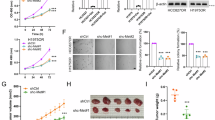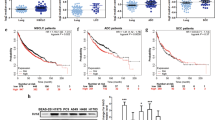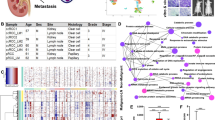Abstract
Aim:
c-Met kinase deregulation is strongly associated with the formation, progression and dissemination of human cancers. In this study we identified Yhhu3813 as a small-molecule inhibitor of c-Met kinase and characterized its antitumor properties both in vitro and in vivo.
Methods:
The activities of different kinases were measured using ELISA assays and signaling proteins in the cells were detected with Western blotting. Cell proliferation was assessed using SRB or MTT assay in twenty human cell lines and cell cycle distribution was determined with flow cytometry. Transwell-based assay was used to evaluate cell migration and invasion. Cell invasive growth was detected by a morphogenesis assay. c-Met overactivated human NSCLC cell line EBC-1 xenografts were used to evaluate the in vivo anti-tumor efficacy.
Results:
Yhhu3813 potently inhibited c-Met kinase activity in vitro with an IC50 value of 2.4±0.3 nmol/L, >400-fold higher than that for a panel of 15 different tyrosine kinases, suggesting a high selectivity of Yhhu3813. The compound (20, 100 and 500 nmol/L) dose-dependently inhibited the phosphorylation of c-Met and its key downstream Akt and Erk signal cascades in multiple c-Met aberrant human cancer cell lines, regardless of the mechanistic complexity in c-Met activation across different cellular contexts. In 20 human cancer cell lines harboring different backgrounds of c-Met expression/activation, Yhhu3813 potently inhibited c-Met-driven cell proliferation via arresting cells at G1/S phase. Furthermore, Yhhu3813 substantially impaired c-Met-mediated cell migration, invasion, scattering, and invasive growth. Oral administration of EBC-1 xenograft mice with Yhhu3813 (50 or 100 mg·kg−1·d−1, qd, for 2 weeks) dose-dependently suppressed the tumor growth, which was correlated with a reduction in the intratumoral proliferation index and c-Met signaling.
Conclusion:
Yhhu3813 is a potent selective inhibitor of c-Met that inhibits c-Met-dependent neoplastic phenotypes of human cancer cells in vitro and in vivo.
Similar content being viewed by others
Log in or create a free account to read this content
Gain free access to this article, as well as selected content from this journal and more on nature.com
or
References
Gherardi E, Birchmeier W, Birchmeier C, Vande Woude G . Targeting MET in cancer: rationale and progress. Nat Rev Cancer 2012; 12: 89–103.
Gherardi E, Youles ME, Miguel RN, Blundell TL, Iamele L, Gough J, et al. Functional map and domain structure of MET, the product of the c-met protooncogene and receptor for hepatocyte growth factor/scatter factor. Proc Natl Acad Sci U S A 2003; 100: 12039–44.
Nakamura T, Mizuno S, Matsumoto K, Sawa Y, Matsuda H . Myocardial protection from ischemia/reperfusion injury by endogenous and exogenous HGF. J Clin Invest 2000; 106: 1511–9.
Christensen JG, Burrows J, Salgia R . c-Met as a target for human cancer and characterization of inhibitors for therapeutic intervention. Cancer Lett 2005; 225: 1–26.
Seiwert TY, Jagadeeswaran R, Faoro L, Janamanchi V, Nallasura V, El Dinali M, et al. The MET receptor tyrosine kinase is a potential novel therapeutic target for head and neck squamous cell carcinoma. Cancer Res 2009; 69: 3021–31.
Knowles LM, Stabile LP, Egloff AM, Rothstein ME, Thomas SM, Gubish CT, et al. HGF and c-Met participate in paracrine tumorigenic pathways in head and neck squamous cell cancer. Clin Cancer Res 2009; 15: 3740–50.
Okuda K, Sasaki H, Yukiue H, Yano M, Fujii Y . Met gene copy number predicts the prognosis for completely resected non-small cell lung cancer. Cancer Sci 2008; 99: 2280–5.
Liu X, Wang Q, Yang G, Marando C, Koblish HK, Hall LM, et al. A novel kinase inhibitor, INCB28060, blocks c-MET-dependent signaling, neoplastic activities, and cross-talk with EGFR and HER-3. Clin Cancer Res 2011; 17: 7127–38.
Toiyama Y, Miki C, Inoue Y, Okugawa Y, Tanaka K, Kusunoki M . Serum hepatocyte growth factor as a prognostic marker for stage II or III colorectal cancer patients. Int J Cancer 2009; 125: 1657–62.
Gupta A, Karakiewicz PI, Roehrborn CG, Lotan Y, Zlotta AR, Shariat SF . Predictive value of plasma hepatocyte growth factor/scatter factor levels in patients with clinically localized prostate cancer. Clin Cancer Res 2008; 14: 7385–90.
Cappuzzo F, Marchetti A, Skokan M, Rossi E, Gajapathy S, Felicioni L, et al. Increased MET gene copy number negatively affects survival of surgically resected non-small-cell lung cancer patients. J Clin Oncol 2009; 27: 1667–74.
Kammula US, Kuntz EJ, Francone TD, Zeng Z, Shia J, Landmann RG, et al. Molecular co-expression of the c-Met oncogene and hepatocyte growth factor in primary colon cancer predicts tumor stage and clinical outcome. Cancer Lett 2007; 248: 219–28.
Comoglio PMTrusolino L . Invasive growth: from development to metastasis. J Clin Invest 2002; 109: 857–62.
Danilkovitch-Miagkova AZbar B . Dysregulation of Met receptor tyrosine kinase activity in invasive tumors. J Clin Invest 2002; 109: 863–7.
Trusolino L, Bertotti A, Comoglio PM . MET signalling: principles and functions in development, organ regeneration and cancer. Nat Rev Mol Cell Biol 2010; 11: 834–48.
Zhang YW, Su Y, Volpert OV, Woude GFV . Hepatocyte growth factor/scatter factor mediates angiogenesis through positive VEGF and negative thrombospondin 1 regulation. Proc Natl Acad Sci U S A 2003; 100: 12718–23.
Nakamura T, Nawa K, Ichihara A . Partial purification and characterization of hepatocyte growth factor from serum of hepatectomized rats. Biochem Biophys Res Commun 1984; 122: 1450–9.
Naldini L, Vigna E, Narsimhan RP, Gaudino G, Zarnegar R, Michalopoulos GK, et al. Hepatocyte growth factor (HGF) stimulates the tyrosine kinase activity of the receptor encoded by the proto-oncogene c-MET. Oncogene 1991; 6: 501–4.
Stoker M, Gherardi E, Perryman M, Gray J . Scatter factor is a fibroblast-derived modulator of epithelial cell mobility. Nature 1987; 327: 239–42.
Sachs M, Weidner KM, Brinkmann V, Walther I, Obermeier A, Ullrich A, et al. Motogenic and morphogenic activity of epithelial receptor tyrosine kinases. J Cell Biol 1996; 133: 1095–107.
Boccaccio C, Comoglio PM . Invasive growth: a MET-driven genetic programme for cancer and stem cells. Nat Rev Cancer 2006; 6: 637–45.
Thompson EW, Newgreen DF, Tarin D . Carcinoma invasion and metastasis: a role for epithelial-mesenchymal transition? Cancer Res 2005; 65: 5991–5; discussion 5995.
Thiery JP . Epithelial-mesenchymal transitions in tumour progression. Nat Rev Cancer 2002; 2: 442–54.
Huber MA, Kraut N, Beug H . Molecular requirements for epithelial-mesenchymal transition during tumor progression. Curr Opin Cell Biol 2005; 17: 548–58.
Blumenschein G. Jr, Mills GB, Gonzalez-Angulo AM . Targeting the hepatocyte growth factor-cMET axis in cancer therapy. J Clin Oncol 2012; 30: 3287–96.
Feldman DR, Einhorn LH, Quinn DI, Loriot Y, Joffe JK, Vaughn DJ, et al. A phase 2 multicenter study of tivantinib (ARQ 197) monotherapy in patients with relapsed or refractory germ cell tumors. Invest New Drugs 2013; 31:1016–22.
Smith DC, Smith MR, Sweeney C, Elfiky AA, Logothetis C, Corn PG, et al. Cabozantinib in patients with advanced prostate cancer: results of a phase II randomized discontinuation trial. J Clin Oncol 2013; 31: 412–9.
Wang MH, Padhye SS, Guin S, Ma Q, Zhou YQ . Potential therapeutics specific to c-MET/RON receptor tyrosine kinases for molecular targeting in cancer therapy. Acta Pharmacol Sin 2010; 31: 1181–8.
Acknowledgements
This work was supported by funds from the National Program on Key Basic Research Project of China (No 2012CB910704), the Natural Science Foundation of China for Innovation Research Group (No 81021062), the National Natural Science Foundation of China (No 81102461), and the National S&T Major Projects (2012ZX09301001-007).
Author information
Authors and Affiliations
Corresponding author
Rights and permissions
About this article
Cite this article
He, Cx., Ai, J., Xing, Wq. et al. Yhhu3813 is a novel selective inhibitor of c-Met Kinase that inhibits c-Met-dependent neoplastic phenotypes of human cancer cells. Acta Pharmacol Sin 35, 89–97 (2014). https://doi.org/10.1038/aps.2013.125
Received:
Accepted:
Published:
Issue date:
DOI: https://doi.org/10.1038/aps.2013.125
Keywords
This article is cited by
-
Novel quinazoline-1,2,3-triazole hybrids with anticancer and MET kinase targeting properties
Scientific Reports (2023)
-
Discovery of a new series of imidazo[1,2-a]pyridine compounds as selective c-Met inhibitors
Acta Pharmacologica Sinica (2016)
-
CoMFA and CoMSIA studies on 6,7-disubstituted-4-phenoxyquinoline derivatives as c-Met kinase inhibitors and anticancer agents
Medicinal Chemistry Research (2015)



